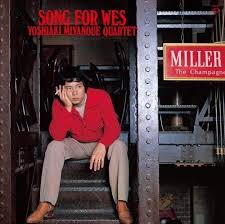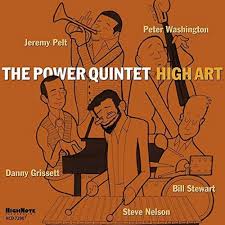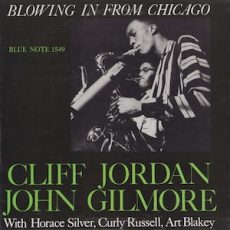
Daily Dose Of Jazz…
Yoshiaki Miyanoue was born in Setagaya, Tokyo, Japan on October 7, 1953. At the age of 10 he took up the guitar. In his last year of junior high school he heard a record by Wes Montgomery and became interested in jazz. During his years at Musashino High School he formed a band and after graduating he joined the New Group Trio with organist Joe Davis and drummer Jerry Eddy. They landed a residency at the N.C.O Club at Yokota Air Base in Yokosuka, Japan for three years. At the same time, he had his own quartet and played at jazz night clubs and bars in Tokyo.
1977 saw him traveling to New York City to develop his artistic strength and maturity. After returning home, Yoshiaki made his national debut, releasing the album Song for Wes for King Record, with Philly Joe Jones as a guest drummer, who was in country with Bill Evans. Thereafter he has released one album after another totalling seventeen to date. Among the guest performers were Jimmy Smith, Dr. Lonnie Smith, and Andrew Simpkins.
In 1981 Miyanoue put together his own group and named it Smokin’. To this day the group has played at night clubs in Tokyo and toured all over the nation. They have appeared on several television and radio music programs while playing at jazz concerts and festivals overseas.
Guitarist Yoshiaki Miyanoue, who was influenced by Wes Montgomery and plucks the strings with his thumb, continues to perform and record.
More Posts: bandleader,guitar,history,instrumental,jazz,music

Daily Dose Of Jazz…
Celia Malheiros was born on October 2, 1960 in Rio de Janeiro, Brazil and from early childhood she was immersed inthe world of Candomblé, an Afro-Brazilian religion. She was introduced to the schools of samba, bossa nova, choro, baião, frevo and indigenous music, as well as Tropicália and political revolutionary movements.
By 18 she was completely supporting herself through music she composed, playing at festivals, theatrical productions, nightclubs, radio and TV shows. She scored films, taught music and led bands to perform her music.
Moving to the U.S. she settled in San Francisco, California where she performed and competed in street carnaval, winning numerous awards. Malheiros spent thirteen years as the music director, arranger and performer with the Brazilian All Star Big Band with Elza Soares, Emilinha Borba and Walter Wanderley. She went on to tour the U.S. opening for the likes of Tony Benett, the Modern Jazz Quartet, Santana and Ray Charles.
Touring internationally as a solo artist and leading her band tRIO, she has accepted commissions by the Wheaton College Choir and the Akat Dance Company. Celia lectures, holds clinics and master classes around the world. She has been a composer in residence at the OMI International Music Program in New York City and artist in residence twice at Massachusetts’ Wheaton College.
Ever vigilant about bringing awareness to the plight of the Amazon’s indigenous and forest, her latest album is also a one woman show. She has more than 50 musicians on each of her albums. Vocalist Celia Malheiros is writing her memoirs.
More Posts: bandleader,guitar,history,instrumental,jazz,music,vocal

Daily Dose Of Jazz…
William Stewart was born on October 1, 1957 in Glasgow, Scotland and started playing classical violin at the age of 10. After winning first prize in the Scottish Central Counties Music Festival in 1970, 1971, 1972 and first prize in the Glasgow Music Festival in 1973, he won the McFarlane scholarship to attend the Royal Scottish Academy of Music in Glasgow at the age of fourteen.
While at the Academy he won the first prize in the Robert Highgate Scholarship for violin in 1975, and went on to play with the Scottish Chamber Orchestra, BBC Scotland, Scottish Opera, Scottish Baroque Ensemble, Virtuosi Scotland. At 19 Stewart toured Britain as leader of the Scottish Ballet Orchestra.
When he turned 21 William left Scotland to take a position as leader of the Passau State Opera Orchestra in Germany before joining the world famous Stuttgart Chamber Orchestra under the direction of Herr. Prof. Karl Munchinger. By twenty-six, as a member of the Stuttgart Chamber Orchestra Quartet, he had played in some of the most famous concert halls in the world, including Carnegie Hall and Lincoln Center in New York City.
For a few years now Stewart has been working on his own compositions and music, blending influences from his traditional Scottish up-bringing, classical music, and love of Eastern-European fiddle music. After many solo concerts, and support for, among others, Nikki Sudden, and Hazel O’Conner at the “Left Bank”, he began playing with local groups like the Jazz Lads and Ellamental. He formed the Klazz with whom he played at the Derry Jazz Festival.
He has recorded with his own quintet “The Bill Stewart Quintet”, and with the gypsy-jazz trio “Gitane Swing”. Violinist William Stewart is now playing jazz, swing jazz, and composing his own works, blending influences from classical and Eastern-European violin music to create a sound that is truly unique.
More Posts: bandleader,history,instrumental,jazz,music,violin

Daily Dose Of Jazz…
Basia was born Barbara Stanisława Trzetrzelewska on September 30, 1954 in Jaworzno, Poland. Growing up in a musical household she enjoyed singing from an early age and had an extensive collection of vinyl records. Her mother played piano and gave her first music lessons.
She began singing professionally in various Polish bands in the late Sixties in a local band Astry. During her first year at Jagiellonian University, the manager of the popular Polish all-female band Alibabki asked her to join the group. She accepted, dropped out and toured with them in 1972 around Poland and abroad until 1974. She performed in Polish rock band Perfect.
Relocating to London, England with her partner in 1981 recorded demo tracks for various artists. It was there she met Danny White and his collaborator Mark Reilly. The trio performed as Bronze, but later changed the name to Matt Bianco and released their debut album Whose Side Are You On? that became a hit across Europe. This catapulted her rise to fame.
She signed on with Epic Records and enjoyed a successful international career between 1987 and 1995, particularly in the US where her first two albums Time and Tide and London Warsaw New York both sold more than a million copies. She released several successful albums throughout the 1990s and into the new century.
She took a lengthy hiatus due to personal tragedies, then made a comeback to regular recording and performing in the late 2000s. Vocalist Basia, currently releases her music through independent labels.
More Posts: bandleader,history,instrumental,jazz,music,vocal

Requisites
Blowing In From Chicago ~ Cliff Jordan & John Gilmore | By Eddie Carter
As a youngster discovering this music, I was always captivated by jazz’s unique and spontaneous nature, particularly the ‘blowing session’ or ‘jam session.’ These impromptu performances, where musicians control the flow of musical ideas from moment to moment, are a testament to the music’s excitement and unpredictability. Whether in a live setting at a club, concert, or jazz festival or captured in a studio session, jazz’s enthusiasm, vitality, and freedom are always present.
This morning’s choice from my library is an excellent LP from 1957 by two tenor saxophonists who made significant impressions in jazz, Clifford Jordan and John Gilmore. Their only album as co-leaders is titled Blowing In From Chicago (Blue Note BLP 1549), which signifies their roots in the vibrant jazz scene of Chicago. The quintet has an excellent rhythm section consisting of Horace Silver on piano, Curly Russell on bass, and Art Blakey on drums. My copy is the 1983 Pathé Marconi-EMI French Mono reissue, sharing the original catalog number. Before I proceed, let me state that this is not a DMM (Digital Metal Mastering) pressing.
The album opener, Status Quo, is a lively tune by John Neely, with both horns leading the charge through the uptempo melody. John rips into the opening solo, aggressively slicing through each verse like a sharp blade. Clifford joins him next in a short exchange, then takes off with a supercharged reading. Horace shifts into high gear on the third statement with a blazing swiftness that’s equally inspired and scintillating. Art engages in a brief conversation with both horns, then brings the solos to a close with an electric performance illustrating his incomparable artistry before the ensemble returns to the theme and quick stop. The first of two originals by Jordan follows.
Bo-Till slows the tempo to a laid-back pace with a Latin flavor. After a short introduction by the trio, the quintet states the theme collectively, stepping aside for Jordan, who makes a profound impression with a beautifully conceived statement displaying a great tone throughout. Silver gets into the groove next with an incredible, smooth reading, one of his best on the album. Gilmore delivers the closing choruses of the song proficiently with meticulous execution. Blakey constructs a concise comment during the ensemble’s end theme and close.
Blue Lights by Gigi Gryce is a catchy tune that opens with the quintet laying down a gorgeous medium beat on the theme and gives everyone a solo opportunity. John steps into the spotlight with a spirited performance. Horace follows with notes of undeniable pleasure in one of his most robust solos. Clifford weaves his way through the next musical improvisation with astounding skill. Curly puts together a condensed reading that walks for one chorus with solid bass lines. Art breezes into a straightforward interpretation that culminates into a splendid summation of the first side.
The second side gets underway with Charlie Parker’s Billie’s Bounce, which gives everyone except Russell a lengthy solo canvas on which to work. Blakey begins with a high-voltage introduction that sets the pace for the following fiery quintet theme. Clifford packs a mighty punch on the opening statement with a fire-breathing showcase, preceding John, who exhibits a robust attack on the subsequent interpretation with extremely hot choruses. Horace takes over next for a scintillating performance, taking his piano on a sizzling uptempo ride. Both horns exchange a few riffs with Art before the drummer gives an unaccompanied propulsive exhibition into the ending theme.
Clifford’s second original is a blues titled Evil Eye, which eases the throttle back from the previous burner to a medium pace with a collective melody by the quintet. Jordan opens the solos with a series of choruses that are smooth and well-structured. In the following presentation, Gilmore shows that he can also interpret blues with plenty of soul, which develops nicely. Silver delivers a lightly swinging performance that expresses pleasure as he moves masterfully through each chorus. Both horns return to share a few more thoughts. Blakey makes a short statement preceding the theme’s reprise and finish.
The album’s final track is Everywhere, a mid-tempo original by Horace Silver, which I believe made its debut on this album. It opens with a simple opening melody by the ensemble in unison, and the solo order is Gilmore, Jordan, Silver, and Blakey. John takes the stage first with a bewitchingly delightful opening statement. Clifford makes his case with a captivating contribution that moves sprightly alongside the rhythm section’s groundwork drive. Horace takes over next, communicating his points well with a pronounced beat. Art puts the joyous exclamation point on the song and album with a compelling statement that leads the group back to the ending theme and close.
Clifford Jordan recorded three albums for Blue Note; the other two LPs are Cliff Jordan and Cliff Craft. He played and recorded with many elite jazz musicians, including Charles Mingus and Max Roach. Clifford also enjoyed success recording as a leader and sideman, and in my opinion, his discography is well worth investigating. He remained in demand over the next three decades and toured worldwide. His final album was a 1992 live recording at Condon’s in New York City for Milestone, where he performed with his big band, Down Through The Years. He lost his battle against lung cancer on March 27, 1993, at age sixty-one.
Blowing In From Chicago was the first of three appearances on Blue Note by John Gilmore. The other two were as a sideman on two of Andrew Hill’s LPs, Andrew and Compulsion. He began playing the clarinet at fourteen, then pursued a musical career after a four-year stint in the United States Air Force, where he took up and played the tenor saxophone. He began a forty-year term with Sun Ra in 1953 and recorded for various labels with his group, Sun Ra Arkestra. During this time, Gilmore also toured with The Jazz Messengers and recorded with Paul Bley, Andrew Hill, Pete LaRoca, McCoy Tyner, and Dizzy Reece. After Sun Ra’s death on May 30, 1993, Gilmore led the Arkestra for two years before his death from emphysema on August 20, 1995, at age sixty-three.
As for the music on Blowing In From Chicago, it’s fantastic, as are the solos on each track, and the sound quality of this reissue is exemplary. The instruments deliver an excellent soundstage throughout the treble, midrange, and bass that places your sweet spot in the studio with the musicians. It’s a cut above the average debut album and a title I recommend as a terrific addition to any jazzophile’s library, particularly if you’re a hard-bop fan or love a good “blowing session” or “jam session.”
~ Andrew (Blue Note BLP 4203/BST 84203), Cliff Jordan (Blue Note BLP 1565), Cliff Craft (Blue Note BLP 1582/BST 81582), Compulsion (Blue Note BLP 4217/BST 84217), Down Through The Years (Milestone MCD-9197-2) – Source: Discogs.com
~ Billie’s Bounce – Source: JazzStandards.com
~ John Gilmore, Andrew Hill, Clifford Jordan – Source: Wikipedia.org
© 2024 by Edward Thomas Carter
More Posts: choice,classic,collectible,collector,history,instrumental,jazz,music,saxophone




